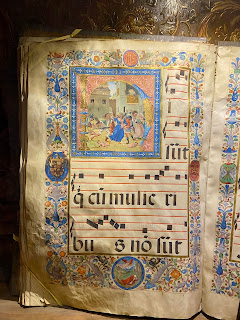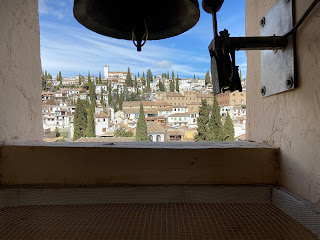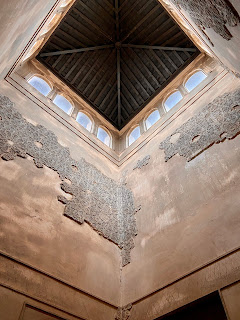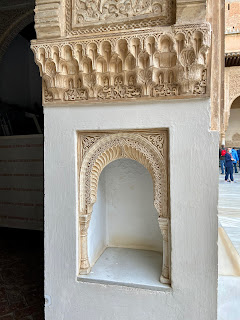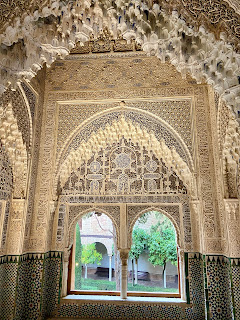Determined to get a view of the Alhambra this morning, we go north, to the closest
mirador available, the
Mirador de San Cristóbal, in the
barrio of
Albacín. We start at the
Puerta de Elvira (eleventh century), an enigmatic fragment of the city's old fortifications.
On the other side of the Puerta is the Plaza del Triunfo, which includes a traffic rotary, which in turns offers a steep street up to our destination, the Cuesta de Alhacaba – cuesta apparently translates to 'cost'. We follow the Cuesta to a stairway, called Cuesta de los Yesqueros, which zigzags up tween the hill houses and terraced walls. More 'cost', but soon Granada spreads out below.
We make it to the Mirador de San Cristóbal, a semi-circular deck that faces south. Even here, we cannot grasp a full image of the Alhambra, as there is the fortified wall, cypress trees, and a small hill of buildings in the foreground. But the entire vista is breathtaking, especially with the light breaking through the eastern clouds and raking the white crests of the mountains.
A cool wind drives us from the viewpoint, as does our scheduled tour of the Alhambra. We descend the steps of the Cuesta de San Cristóbal and chase the old walls along the Carril de la Lona. There is another mirador there with views to the west. More stairs and our descent quickens.
We wind our way through the Albacín, to the Río Darro, which is not so much a river as a creek, but lush, truly picturesque. We are at the base of the Alhambra, far below its northern walls, and we can see the tops of the towers.
From below the Alhambra, to the north and west, we have to get to the
Pabellón de Acceso de la Alhambra, where we are meeting
our guide, Asier. It's all the way at the
other end. Both Google Maps and Apple Maps suggest alternate routes, but our research ('paper' maps) says to take the Cuesta del Rey Chico.
This Cuesta is a rising, stepped road in the valley between the terraced gardens of the Generalife and the northeastern walls of the Alhambra. It's a lovely stroll, with views on all sides, and even the walls hold a fascination.




We arrive at the Pabellón right on time. We catch our breath for a few seconds and begin our
guided tour of the Alhambra. Why a guided tour: well, it's an expense, but the Alhambra is a top-level architect's life-list destination. A guide will make sure we get to all the best things within the given time. We won't get lost or overly distracted – cause the Alhambra is
a lot.
We begin by crossing to the
Generalife (thirteenth century), the 'summer palace'. Asier tells us to think of the Alhambra as a 'city'. The terraced gardens aren't there for pleasure, they're there for food production. But the walk is quite pleasurable, as we track the parapet along the Jardines Bajos, the formals gardens which are under restoration.
Asier notes that many of the thick, taller hedges aren't getting enough sun or water, and are dying from the inside out. He adds that many of the plantings are used to indicate lost constructions. That is, rather than false 'reconstructions', their memories are carried by forms in the garden, which serves as a living floor plan.






After trailing the lengthy garden wall to the west, we turn right and ascend to the
Palacio del Generalife. From the lower garden, it appears be a good-sized house, but not 'palatial'. We cross a forecourt, then a little
jardín, turn around a set of stairs, and find ourselves looking down the Patio de la Acequia (
acequia translates to 'irrigation ditch'). With dancing water hoops, the canal and flower beds, and the decorated arched portico, the Patio is vibrant and photogenic.
We traverse the galeria, to the north portico. The arcade itself is quite plain, but there are excellent views over the valley to the Alhambra, as well as into the Patio.
The north portico is properly adorned with the intricate reliefs and Arabic script we expected; everything here looks authentic and well-preserved. Just behind the portico is the Sala Regia, richly carved, with screened windows along the clerestory, and a stunning wood-mosaic ceiling.
Asier lists a few key design issues:
- the Nasrid occupants, who believed in privacy, would have screened the arcade;
- the approach to an important space involves multiple turns and is usually from the side, since a 'corner view' allows the entire space to been seen at once;
- water features are at the centers of the main courtyards ignorer to moderate the temperature and reflect the light; and
- the current state of the Generalife is the result of damage from earthquakes, fires, a Christian Reconquista, and nearly three hundred years of private ownership, during which the Palacio and Jardines were made to look more 'Italianate'.










We end our tour of the Generalife in the Patio de la Alberca (alberca translates to 'reservoir'), also called the Patio de la Sultana. It is more intimate that the Acequia, but with a larger raised pools and fountains. In one corner is a gated cave-like opening which is the water source for the entire 'city'. The water rushes out of the cistern through a channel in the Patio floor, and out to the rest of the Alhambra.
Up the stairs, we reach a lookout from which we can see the ruins of the old servants' quarters (Casa de Servicio), and more amazing views of Granada and the Albacín. Asier rather gleefully points out the toilet.
Our first impression, however, is positive. In parts, the Palacio is gorgeous, though in places it looks quite disheveled and in need of help. In terms of the tour, it's an appetizer.
As we return east on a path framed by rows of oleanders, Asier instructs us to 'follow the water'.
We enter the Alhambra proper from an arched bridge over the Cuesta del Rey Chico. Just to the east is a thinner stone arch which is the water supply aqueduct, the Acequia Real de la Alhambra (another 'irrigation ditch'). The nearby fortress tower, the Torre del Agua, is a storage tank.
In the walls of the Alhambra, this area at the eastern end is called Medina, and holds the ruins of the village that housed those who supported the palaces, including high officials as well as servants. The village also had facilities for food prep, material fabrication, and more toilets.
The main road, the Calle Real de la Alhambra, runs east-west behind the southern walls. The first palace we reach is the Palacio de los Abencerrajes, an excavated ruin and
archeological site. The Palacio covers a wide swath, and features tiled floors, terraces, water systems, and a central pool.
There is a distressed-looking tree in the middle of the site, its root ball partially exposed. Asier says that the are caught between the desire to save the tree or to sustain the excavation.
Across the street is the
Baño de la Mezquita (baths of the mosque), the city's old
hammam. Only shards of the original finishes remain, and hint at the Baño's splendor 'back in the day'.
Exiting the Baño, we enter a small commercial area, stores selling post cars and ice cream. Asier explains that this part of the Alhambra is public.
The
Palacio de Carlos V (sixteenth century) comes into view, perhaps more invasive than the retail strip inside the defensive walls. The entry porticos are under restoration, hidden by scaffolding and fabric, so we only see the corners. The base is heavily rusticated, with a chiseled or hammered surface; the column capitals only suggest a classical order. The upper level is more refined, with Ionic pilasters raised on a series of pedestals. Each bay on each level, includes an oculus over the window.
Asier mentions that the architect,
Pedro Machuca, was greatly influenced by
Giulio Romano, and the connection is apparent in the exaggerated rustication and the play with heights. The interior courtyard is an uninterrupted circular colonnade, its purity perhaps more disorienting than any
Mannerist 'optical illusion'.
In the southwestern corner of the Plaza de Palacio de Carlos V is the
Puerta del Vino, which served as the last security checkpoint before the 'inner sanctum'. On the inside of the Puerta, in the keystone, Asier points out the 'key', a symbol of greeting or welcome. It's the end of the Calle Real. Also, there are restrooms, souvenirs, and vending machines.
The Plaza ramps down to two courtyards, the Patio de Mezquita and the Patio de Machuca, after
the architect of the Palacio. The Patios incorporate a ruined portion of the
Palacio del Mexuar (early fourteenth century), the first of the
Palacios Nazaríes. Again, the walls of the courtyards and some of the rooms are expressed by the topiaries. And again, the Palacio resembles an apartment block in the Albacín, not necessarily a 'palace'.








Inside the Palacio is the
Sala del Mexuar, richly decorated, but full of post-Nasrid interventions: royal crowns, tile panels, a painted Doric frieze, and a 'catwalk' balustrade dividing the space. At the same time, the poly-chrome of the old reliefs is more evident here than in the Generalife, especially around the
mocábare, 'honeycomb' column capital and the upper portion of the exterior wall. We need to use our imaginations to 'fill in the blanks', but it's easier now to see how the color, the carving, and the dappled light would meld to dazzle visitors.
But Asier warns us that much of the art and tile work is, in fact, not authentic. Many of the restorations contain shortcuts, and poorly researched repairs.
We carry Asier's warnings to the one remaining courtyard of the Palacio is the
Patio de Cuarto Dorado, which looks on the
Fachada de Comares. Here the wall ornament appears to be 'patchy', with variations in tone and texture that look 'wrong'. The ceramic wainscot, for example, looks too simple, but the bollards and belts keeping the public at a distance suggest an effort has been made in its preservation.
The Fachada appears as fired earthenware, but the opposite wall seems to be white, like porcelain. The decorative work turns the corner, but after a short distance, is gone from each side as well as the area above the opposite wall.
On the other side the Fachada (the left-hand door), the portico says more about how the rest of the space must have appeared, with a twelve-pointed star pattern, friezes of Arabic script, and a corbeled cornice with faint pigment. Despite the 'incompleteness', the Fachada is remarkable.
The level of decoration builds as we enter the
Palacio de Comares (thirteenth century). We make a U-turn and end up in the
Patio de Arrayanes. It's uncertain if this Palacio is more 'intact', but it gives a sense of being 'more complete'.
The Patio de Arrayanes is a broad, open quadrangle akin to the Patio de la Acequia in the Generalife, except quieter (not counting the people). There are no flowers or sprinklers, but clean-cut hedge rows and a reflecting pool – everything is still. On our left is the Torre de Comares.
In the archway, as we step into the Patio, we notice pocket-sized carved niches; Asier says these are for candles. To enter the Torre, we first pass through the portico; on the ends of the portico are alcoves with their popular 'stalactites' (examples of mocárabe domes close to eye level, and much-photographed).
Next we enter the
Sala de la Barca, another long reception space with a striking, coved, wood-mosaic ceiling. On the way in we notice another candle niche, but this one presents a sample-in-miniature of the missing poly-chrome (protected behind glass) – the Arabic script and the designs in the relief 'popping', even a perfect, tiny
tessellation. We imagine these colors everywhere.
As we are leaving, the Patio, Asier gestures to the end of the pool – it's the key symbol welcoming us again.
Now we make it to the
Salón de Embajadores, the throne room. Out of respect, it is not overly illuminated, and it takes a second for our eyes to adjust. The filtered light from the screened windows makes the ceiling glisten, like seeing stars. In this room more than anywhere else, we truly get a taste for how this architecture is really supposed to work.
It feels as if we're in a double-height cube, though it might not all be square. With our movement, the changing light seems to bring the surfaces alive.
Out a short passage, and we arrive at the
Patio de los Leones, and another celebration of water. More '
honeycomb' corbeling leads us to a
templo or columned pavilion. Again, there are sensational shadows and highlights.
The
Palacio de los Leones (fourteenth century) is the newest of the three Nasrid palaces. It is also the most private, as Mexuar is for reception, Comares is for state business, and Leones is more 'residential'. But, as Asier describes, a bedroom or a dining room could be anywhere – the rooms do not have specific functions.
The Patio de los Leones joins three spectacular rooms: the Sala de Abencerrajes, the Sala de los Reyes, and the Sala de las Dos Hermanas.
The Sala de Abencerrajes features a octagonal dome, with a tighter, taller central section in the form of an eight-pointed star, all the stalactites raining light. We hear another tour guide commanding his charges, "Go in, take your pictures, and meet me out here."
The
Sala de los Reyes is another neck-strainer. But in this case, the Christian influences absorb our interest. In a series of recesses, we find painted scenes in the oval domes; gorgeous medieval-style images of the Nasrid kings – in the spirit of the
Arabian Nights. Common knowledge says that
painting should never represent human figures, but here we see the exception to the rule – perhaps the artists were captured Christians. Anyway, they are tucked away in this very private space.
In another 'intervention', just outside the Sala de los Reyes are the initials of
Washington Irving, scratched into a shield in the hallway: "
WI, 1829". The author of
Tales of the Alhambra (1832) is very popular with the people of Granada; his stories must have served as an early travel brochure, luring tourists.
We finish our trip through the Palacios Nazaríes at the
Sala de las dos Hermanas, with perhaps the largest and most intricate
mocárabe dome. We zoom and stare into our iPhones trying to focus, but there's a level of fractal reduction we cannot capture. Less color than the Sala de los Reyes, but it's got lots of sparkle, like the underside of a snow cap.
The large domed room leads to a passage, and then a belvedere with window seats on three sides, known as the
Mirador de Lindaraja. The color and pattern of the walls, and the
mocárabes are enchanting, and of a scale that allows close scrutiny. This room also hides a special ceiling: a geometric wood lattice with stained glass.
The Mirador looks out on a beautiful private garden, with a templo, but rendered in trees.
We depart the Palacios Nazaríes, with views to the Albacín and the
Palacio del Partal. We wander through the gardens and process what we've seen. Asier says the tree in the garden blooms for only one week every year, and that we are lucky to have caught it. Almost without thinking, we snap pictures, still processing.
We conclude the tour at the
Alcazaba (thirteenth century), the fortress of the Alhambra. Inside the towers, the foundations of a military village are visible, quarters for the officers and officials.
We go down to one of the lower towers, Torre de las Armas, which is a broad, out-stretched platform with terrific views to Granada as well as back to the fortress.
I ask Asier, why the Torre de la Vela is flying a
Portuguese flag. He smiles and replies that it's the flag of the city of
Granada.
It's close to closing time. We thank Asier, and leave the Alhambra though the Puerta de la Justicia. This delivers us to the Bosque de la Alhambra (Cuesta de Gomérez), and an easy, downward walk home.




















